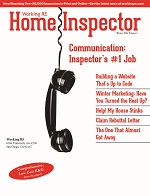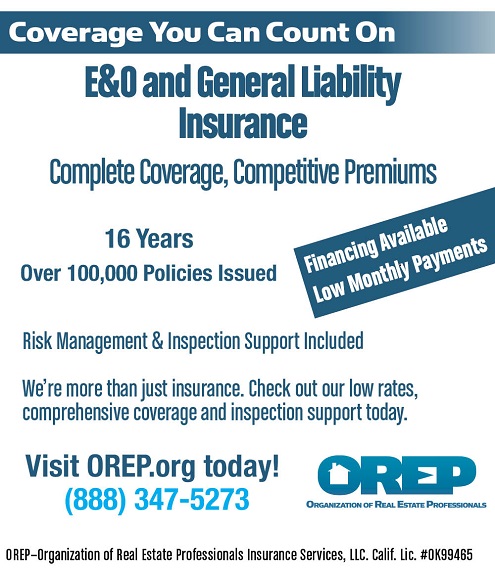 |
> E&O You Can Count On E&O/GL Insurance for Home Inspectors- *Broad Coverage *$1,000 minimum premium (choice of limits/deductibles) Shop OREP Now! |
Editor’s Note: This story appears in Working RE Home Inspector’s NEW January Print Edition. OREP E&O insureds receive guaranteed delivery of each print issue along with many other valuable business benefits.
> Now reaching 20,000+ Home Inspectors in Print and Online!
Radon Detection: Being Experts in the Invisible
by Billy McFadden, General Manager at Airthings
When a home inspector walks into a house he or she is expected to know safety code, to uncover potential hazards and to see the invisible. Is the roof in good shape? Does the plumbing work as it should? Is the electrical system safe enough to handle the current load? Beyond the visible, inspectors must be experts in the invisible. This includes detecting invisible radon gas.
Radon is a colorless, odorless and tasteless radioactive gas. It is the number one cause of lung cancer among non-smokers, killing about 58 people per day in the United States. The only way to discover how much radon is present in a home is through testing.
Radon is found everywhere as part of the air we breathe. It concentrates when it becomes trapped indoors. According to the EPA, radon can be found in all 50 states and in one in 15 US homes. Radon levels often very significant–-two homes right next to each other can have completely different radon levels. That is why no region is exempt from measuring radon. Modern buildings are often well insulated and windows are usually kept closed. This can allow radon to build up to levels where our internal DNA repair system can no longer keep all cells healthy. Radon can enter a home or workplace through the hot water tank, sink, shower, and microscopic cracks in a building´s foundation.
Most people haven’t heard about radon or the danger it poses because it does not show symptoms until years later. The process that forms radon is also complex. The rocks and soil beneath our homes contain traces of uranium. Over time, the uranium breaks down and forms other elements. This is called radioactive decay. Radon is one link in the decay process which emits radioactive radiation in the form of an alpha particle.
These particles can’t hurt you through your skin but when you breathe them in, they can cause damage. Because the tissue inside your lungs is living, the radon particles are absorbed.
The way radon is measured is complicated and unlike anything else measured for home inspection, which is why so many inspectors are now radon certified. When testing radiation from the progeny, rather than radon itself, the measurements are usually expressed in working level (WL) units. When radiation from radon is measured directly, the amount is usually expressed in picocuries per liter of air (pCi/L).
(story continues below)
There is no safe level of radon according to the EPA. However, radon is something that can be mitigated. The EPA recommends mitigation if your home measures more than 4 pCi/L on average. It is best to measure levels over a long period because of the fluctuating nature of radon, however, most home inspector tests are between two-seven days. The longer you test, the more accurate your reading. And it is important to remember there is no such thing as a safe level of radon.
Radon is a serious health issue and the leading cause of lung cancer for non-smokers. Radon is responsible for 21,000 deaths each year in the United States alone. This is more than six times the number of deaths annually attributed to house fires and carbon monoxide poisoning combined.
Radon exposure is easily managed by monitoring your daily levels. Radon detectors and awareness are becoming increasingly common. Detectors, such as the Corentium Pro—made by Airthings, is made with home inspectors in mind.
About the Author
Billy McFadden is the General Manager, Head of Sales US at Airthings. Founded in 2008, Airthings is a tech-based company specializing in cutting-edge products to easily monitor radon levels in indoor air. The Corentium Pro, made by Airthings, is the new standard for professional radon detectors. Its proprietary detection system combines accuracy with the ease of use and portability of a digital device. Since it is battery powered, there is no need to find an outlet, and the battery lasts for at least 1.5 years. It has quadruple redundancy built into its system, with four detection chambers to make sure results are both accurate and deliverable on time.
> Free Webinar:
Claims and Complaints: How to Stay Out of Trouble
Available Now
Presenter: David Brauner, Senior Insurance Broker OREP
David Brauner, Senior Broker at OREP, shares insights and advice gained over 20+ years of providing E&O insurance for inspectors, showing you how to protect yourself and your business. Watch Now!
Note: The September 2017 issue of Working RE Inspector mailed to over 20,000 home inspectors nationwide. OREP Insureds enjoy guaranteed delivery of each print magazine and many more benefits.



